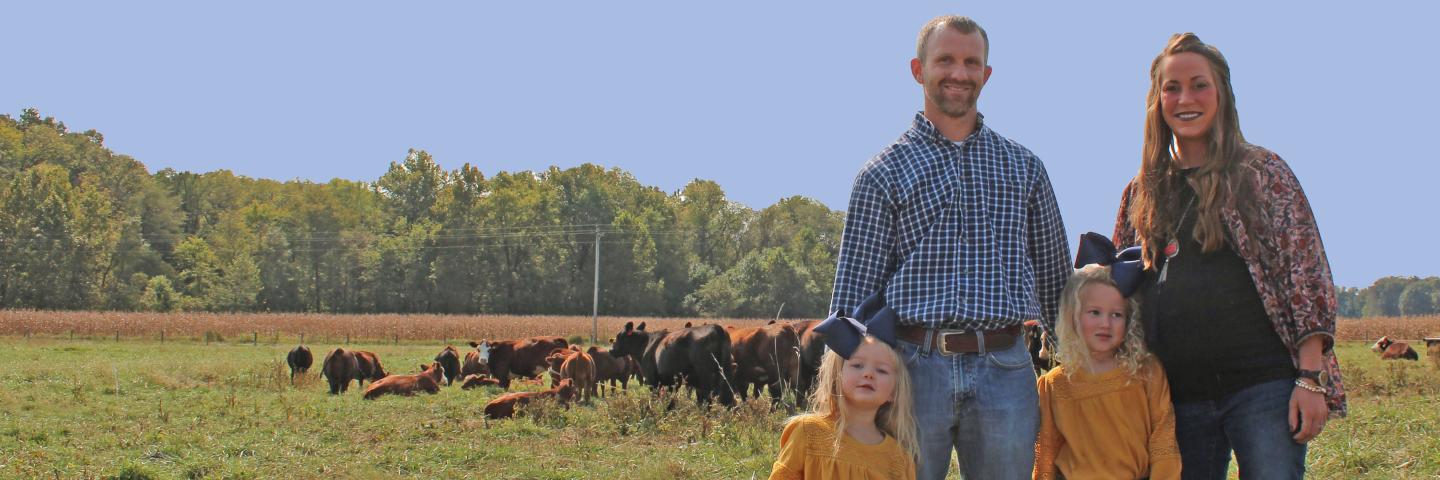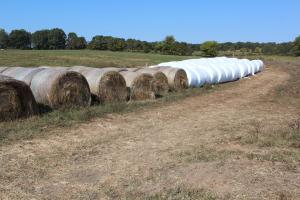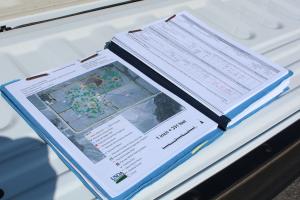
Meet Grant & Casey Bauman from Vienna, IL. Read their story to learn about their grazing operation and their close relationship with conservation.
GRANT & CASEY BAUMAN
Bauman Family Farms-Vienna, IL
Overview
Grant and Casey Bauman and their three children run a grass-based cattle operation just outside of Vienna, Illinois. They run a South Poll/Red Angus cow-calf herd of about 100 head, raise grass-based breeding stock, and produce grass-fed and grass-finished beef. Their philosophy is grounded in a desire to improve the health of their land, animals, and community, “We strive to work with nature to improve our soils, grass, and produce healthy beef,” Grant explains.

Grant comes from a farming background and became interested in raising grass-fed beef on rotationally grazed pasture in college. Grant bought a herd of cows and traded labor for access to pasture, using an adaptive high stock density (AHSD) grazing model he’d observed in action on Greg Judy’s grazing operation in Rucker, Missouri.
The Baumans have been working their current farm since 2014, which is a patchwork of land that they own and rent. They use AHSD grazing and customize management depending on location and management goals for the land. They graze both cover crops and perennial pasture, using cover crop grazing to extend the length of the grazing season.
Adaptive Management
Grant says that his family enjoys the work of moving cattle. Many people assume that AHSD grazing requires significantly more time due to frequent rotations, but Grant has found that it does not. He notes that the process of moving fencing and observing the cattle is also far more pleasant than highly mechanized production systems where farmers often find themselves sitting in brush hogs for hours at a time.
As with many grazing operations, there were resource concerns on the farm that needed to be addressed to help become a more functional and profitable operation. Grant and Casey reached out to the local NRCS office in Vienna for assistance. A Grazing Management Plan was developed, and financial assistance was applied for through the Environmental Quality Incentives Program (EQIP).
Grant and Casey used EQIP funds to install water lines and some interior fencing. Both investments have markedly improved the flexibility of their operation. Easy access to water is critical for regenerative grazing operations and represents significant time and cost savings for the farmer.
The Baumans have permanent water sources, like ponds and the piped water lines, which allow them to customize internal subdivisions of the paddocks. Most of their external fencing is barbed wire and they use polywire to create temporary paddocks. This allows for maximum flexibility in paddock design. The Baumans also use portable shade that can be easily moved between paddocks and protects cattle from heat stress. Grant and Casey have not yet participated in the Conservation Stewardship Program (CSP), but it is on their radar for the future.

Breeding for Resilience
The majority of the Bauman’s cattle are South Poll cattle. South Polls are bred to thrive in grass-based systems. Through selective management of their animals, Grant and Casey are further shaping herd genetics to be well adapted to the specific environment and conditions in southern Illinois. They run a closed herd, introducing bulls to maintain the genetic diversity of the herd.
Grant targets April and May for calving. This is intentional, because as Grant explains the spring is when forage quality and production are at a peak. Calving during these productive months allows the cows to meet heightened nutritional requirements during lactation.
The frequent rotations required by an AHSD grazing regime give the Baumans ample opportunity to monitor their cattle and observe them in action. This includes careful consideration of which animals are making consistent gains and those that are not. Animals that don’t make steady gains are culled from the herd, improving the overall resilience and local adaptivity of the herd.
Grazing Impacts
In their adoption of an adaptive model based on regeneration and biomimicry, the Baumans have departed from a conventional, input-based mindset. “We’re promoting life, and we’re trying to work in unison with everything that’s out there.” The way they manage their livestock has had profound impact on their land. “All life begins with the soil, everything we do is centered on building and improving the health of the soil.”
Grant describes marked improvements in forage quality, greater abundance and diversity of bird and insect populations, and increased soil organic matter. In one particular paddock, Grant measured a 3% increase in soil organic matter over a period of four years. Soil that contains higher levels of organic matter can infiltrate more water and contains more nutrients for plants and soil microbes. Quail, martins, cowbirds are abundant on the farm and help manage insect populations.
Growing Grazing
The most significant challenge that the Baumans have faced in growing their operation is limited access to quality forage. They’ve extended the grazing season by grazing cover crops, but high-quality forage is hard to come by. Grant grazes cattle on rented land 15 miles away, and notes that while rented land can provide more flexibility and help farmers scale their operations, increased travel time for the farmer means fewer rotations are possible in a day.
The Baumans are primarily in the cow-calf business and are still in the early stages of marketing their grass-finished product. They currently sell beef by the quarter and half, mostly to friends and family and have launched additional promotion on Facebook. Grant hopes to increase the number of cattle that they grass finish themselves.
Grant sees momentum locally around grass-based operations and regenerative farming practices. He says that the last several years have been hard for conventional production. This has compelled some farmers to look for alternatives, searching for opportunities to diversify revenue streams and build farm financial resilience. A growing community of regenerative practitioners and educators supports this growing interest has accelerated interest in AHSD grazing in the region.
Grant says the key to establishing successful grass based operations is a combination of education and strong herd genetics. Bauman Family Farms is a family operation, and Grant and Casey have extended their commitment to family and community well beyond the farm gate. They go to every grazing conference they can, attend field days, and talk to other producers.
The Baumans, in partnership with NRCS, the Illinois Grazing Lands Coalition, the Pasture Project, and other partners, have also hosted field days on their farm and advocated for regenerative management on webinars. Grant reflects on their system and management, saying “It finally feels like we’re doing what’s right for the environment, right for the animals, and right for our family, and hopefully for many other families by providing beef.”
To learn more about Bauman Family Farms, visit their Facebook page or reach out to them via email at baumanfamilyfarms@gmail.com.

